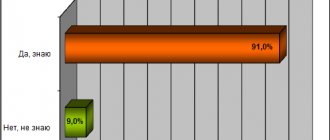Formulas for calculating utility bills in a separate apartment or house
To establish the amount of payment for hot and cold water supply in apartments not equipped with individual meters, the following formula is used:
P = t*N*n , where
t – cost of the rate for the resource;
N – existing consumption standard;
n – number of residents.
If there are metering devices in the residential premises, the formula takes on a different form:
Р = t*V
Here " t " still denotes the tariff rate.
The second component of formula V is the amount of resource consumed according to the meter readings.
When calculating heating fees in houses without meters, the formula is taken
P = t*N*Sq , in which Sq is the total area of the apartment.
If collective heat energy metering devices are installed in the house, the formula becomes a little more complicated:
P = Sq/ Sd* V* t, “Sd” denotes the total area of all apartments in a given apartment building.
The amount of payment for utility services for gas supply in a residential premises that is not equipped with an individual or shared (apartment) gas meter:
Where:
S is the total area of the i-th residential premises;
N gas.o . — standard consumption of utility services for gas supply for heating residential premises;
n is the number of citizens permanently and temporarily residing in residential premises;
N gas.p. — standard consumption of utility services for gas supply for cooking;
N gas.in. — standard consumption of utility services for gas supply for water heating in the absence of centralized hot water supply;
T is the tariff (price) for gas established in accordance with the legislation of the Russian Federation.
Recalculation according to the marginal index - for many of us, these are the magic numbers in the payment slip, according to which we must pay less than the actual cost of utilities.
But how can you tell whether these numbers are correct, or whether the cunning people from the housing and communal services reduced the fees solely at their own discretion?
In some bills it is designated as “recalculation according to the marginal index”, in others as “compensation for expenses for utility bills”, but everywhere the meaning is the same: the marginal index sets the bar for the growth of fees for utility services, and if utilities rise in price faster Than this is established by the limit index, this growth is compensated by the state.
According to Article 157.1. The Housing Code of the Russian Federation does not allow an increase in the amount of fees paid by citizens for utility services above the maximum indices for changes in the amount of fees for utility services in municipalities approved by the highest official of the constituent entity of the Russian Federation.
In practice, everything is quite simple: the amount of payment for all utilities that you pay in the current month should not be higher than the amount of payment for all utilities that you paid in the base period by the size of the established limit index.
The base period is December of the previous calendar year. The marginal index is measured as a percentage. If the marginal index is equal to X%, then the amount of payment for utilities should not be greater than the amount of payment for December increased by X%.
If you live in the same apartment, you have a constant number of residents, and every month you consume approximately the same amount of utilities, then everything is simple for you.
To check the correctness of the recalculation (compensation) according to the marginal index, you pick up the payment slip for December of the previous year and see how much you paid for all utilities.
| Communication service | Volume | Rate | Accrued | Sum | Recalculation | To pay | |
| Cold water | cubic meters | 3,3 | 13,88 | 45,80 | 1566,27 | 88,71 | 1477,56 |
| Cold water for domestic hot water | cubic meters | 2,5 | 13,88 | 34,70 | |||
| Heat for domestic hot water | Gcal | 0,16125 | 1341,34 | 216,29 | |||
| Water disposal | cubic meters | 6,8 | 9,92 | 67,45 | |||
| Heating | Gcal | 0,678 | 1341,34 | 909,43 | |||
| Electricity | kW/h | 220 | 1,33 | 292,60 |
Receipt 1. As you can see, for December of the previous year we paid 1477 rubles 56k. See exactly the actual payment amount.
Then you take that amount and multiply it by (100% + Cap Index(%))/100%.
For example, in the Krasnoyarsk Territory, in the second half of 2020, the limit index was set at 8.9%, so for the Krasnoyarsk Territory we will multiply by 1.089 (108.9%).
We compare the resulting figure with the one written on our payment slip for the current month. For example, for August.
| Communication service | Volume | Rate | Accrued | Sum | Recalculation | To pay | |
| Cold water | cubic meters | 3,3 | 15,56 | 51,35 | 2011,8 | 402,73 | 1609,06 |
| Cold water for domestic hot water | cubic meters | 2,5 | 15,56 | 38,9 | |||
| Heat for domestic hot water | Gcal | 0,16125 | 1448,35 | 233,57 | |||
| Water disposal | cubic meters | 6,8 | 9,97 | 67,80 | |||
| Heating | Gcal | 0,678 | 1448,65 | 982,18 | |||
| Electricity | kW/h | 220 | 1,45 | 319 |
Receipt 2. As you can see, the amount of payment for utilities, taking into account recalculation according to the marginal index, increased by the same 8.9%. If you got about the same thing, then you don’t have to read further.
This method of checking the correctness of recalculation based on the limit index is correct for 80% of owners. But the experience of the People's Control reception offices in housing and communal services has shown that in the remaining 20% of cases questions and problems arise.
What are these cases:
1) The consumption standards for a particular utility service have changed.
2) The volume of consumption of utilities by the residents of your apartment has changed.
3) The number of residents has changed.
4) You moved to a new place of residence.
5) You have installed individual metering devices.
To understand all these cases, let’s look at how the mechanism for limiting the growth of utility bills works.
The size of the indices and the procedure for their application are determined in accordance with Decree of the Government of the Russian Federation dated April 30, 2014 No. 400. For brevity, we will call it Decree No. 400.
In accordance with paragraph 10 of Resolution No. 400, the use of limit indexes must ensure that the payment for utilities in each month of the current year increases to the amount of payment for utilities in December of the previous year (base period) by no more than the established value of the limit index.
That is, if we have set a limit index of 8.9%, then the increase in fees for utilities should not be higher than 8.9%, and everything that goes beyond this value is asked by the utility provider not from the owners, but from the state .
According to paragraph 5 of Resolution No. 400, when applying and calculating marginal indices and indices for the constituent entities of the Russian Federation , the difference in the amount of payments arising as a result of
:
1) changes in the set of utilities;
2) changes in the amount of payment of citizens for utility services, which is due to a change in the volume of consumption of utility services, determined by the readings of utility metering devices;
3) changes in the volume of subsidies provided to citizens provided for in Article 159 of the Housing Code of the Russian Federation, and measures of social support for the payment of utility services, with the exception of measures of additional social support aimed at complying with the established limit indices;
4) changes in actual consumption volumes as a result of recalculation of the amount of payment for utility services for past billing periods, in the manner established by Decree of the Government of the Russian Federation dated May 6, 2011 No. 354 “On the provision of utility services to owners and users of premises in apartment buildings and residential buildings”;
5) transition to payments for utility services using prices (tariffs) differentiated by time of day (established periods of time);
6) application, in accordance with the legislation of the Russian Federation, of penalties that increase coefficients to tariffs and standards, for example, penalty coefficients for uninstalled metering devices;
7) application of consumption standards differentiated by month of the calendar year, established in accordance with the legislation of the Russian Federation;
 transition after January 1, 2020 from the application of the procedure for calculating the amount of payment for utility services for heating evenly for all billing months of the calendar year to the application of the procedure for calculating the amount of payment for utility services for heating for a period equal to the duration of the heating period.
transition after January 1, 2020 from the application of the procedure for calculating the amount of payment for utility services for heating evenly for all billing months of the calendar year to the application of the procedure for calculating the amount of payment for utility services for heating for a period equal to the duration of the heating period.
It is important to note. When recalculating, the full range of provided utilities is taken into account
In accordance with paragraph 2 of Resolution No. 400, the structure of citizens' payments for utility services is established in accordance with Part 4 of Article 154 of the Housing Code of the Russian Federation.
According to Part 4 of Article 154 of the Housing Code of the Russian Federation, fees for utility services include fees for hot water supply, cold water supply, sewerage, electricity supply, gas supply (including supplies of domestic gas in cylinders), heating (heat supply, including supplies of solid fuel in the presence of stove heating).
Thus,
The amount of payment for utility services paid by citizens according to the marginal index is calculated based on the amount of payment for utility services provided to the citizen.
The accuracy of recalculation based on the limit index depends on how the utility service provider takes into account all these features.
Let's sort it out in order.
The range of utilities has changed.
In this case, recalculation is made based on the volume of utilities that was in effect in December of the previous calendar year (in the base period).
For example, in December of the previous year you did not have gas, but during the current year it appeared. In this case, the payment amount for all utilities is taken, the payment for gas is removed from it, and a recalculation is made to the resulting total amount.
Reverse example. In December of the previous year you had gas, but now your apartment is disconnected from the gas supply. In this case, the recalculation does not take into account the gas payment that was in December of the previous year (in the base period).
The volume of utility service consumption determined by individual metering devices or standards has changed.
In this case, if we consumed more resources than in December of the previous year, then we receive a recalculation only for that part that is equal to that consumed in that same December of the previous year.
And if we consumed less of a resource than in December of the previous year, then during recalculation we reduce the amount of payment for utility services in December of the previous period as if we consumed less of this utility resource then.
Example
, in December of the previous year we consumed this much resources and paid this much money for them.
| Communication service | Volume | Rate | Accrued | Sum | Recalculation | To pay | |
| Cold water | cubic meters | 3,3 | 13,88 | 45,80 | 1566,27 | 88,71 | 1477,56 |
| Cold water for domestic hot water | cubic meters | 2,5 | 13,88 | 34,70 | |||
| Heat for domestic hot water | Gcal | 0,16125 | 1341,34 | 216,29 | |||
| Water disposal | cubic meters | 6,8 | 9,92 | 67,45 | |||
| Heating | Gcal | 0,678 | 1341,34 | 909,43 | |||
| Electricity | kW/h | 220 | 1,33 | 292,60 |
Receipt 3.
And this month we have already consumed so many resources:
| Communication service | Volume | Rate | Accrued | Sum | Recalculation | To pay |
| Cold water | cubic meters | 4,5 | 15,56 | 70,02 | 1609,72 | |
| Cold water for domestic hot water | cubic meters | 1,5 | 15,56 | 23,34 | ||
| Heat for domestic hot water | Gcal | 0,09675 | 1448,35 | 140,13 | ||
| Water disposal | cubic meters | 6,8 | 9,97 | 67,80 | ||
| Heating | Gcal | 0,678 | 1448,65 | 982,18 | ||
| Electricity | kW/h | 225 | 1,45 | 326,25 |
Receipt 4.
As you can see, we consumed 1.2 cubic meters of cold water. meters more, hot water was consumed by 1 cubic meter less, and drainage accordingly increased by 0.2 cubic meters, and we spent 5 kW/h more electricity. Due to this change in consumption volume, we have a difference in payment equal to:
differencexvs = 1.2 cubic meters * 15.56 rubles = 18.67 rubles
difference in hot water = -1cub.m*15.56+-1cub.m*0.0645Gcal/cub.m*1448.35r = -108.98r
differenceelectric = 5kW/h*1.45r = 7.25r
total difference = -83 rub 06 k.
These -83 rubles 06 kopecks are not taken into account when recalculating according to the limit index. That is, when recalculating, we do not take into account this difference in the cost of utilities in the current month. Moreover, as you have already noticed, this difference can be both positive and negative.
In this example, if utility consumption were at the same level as in December of the previous year, the maximum utility cost would be:
1477 RUR 56 k * 108.9% = 1609 RUR 06 k
but as we calculated, we should not take into account the difference of -83 rubles 06 kopecks, which arose due to changes in the volume of consumption of utilities. We simply add the resulting difference to this number:
1609r 06k + -83r 06k = 1526r
This should be the amount that we must pay this month for all utilities, taking into account all the requirements of Resolution No. 400.
If consumption standards or the number of residents have changed, then we do the same, only the consumption volumes will be equal to the corresponding standards multiplied by the number of residents.
You have installed individual metering devices.
If you installed new metering devices this year, and in December of the previous year you made charges according to the standards, then you do the same as if the consumption of utility services has changed. At the same time, consumption in December of the previous year is equal to the standard then in force, and consumption in the current month is taken according to meter readings.
Transition to payments for utility services using prices (tariffs) differentiated by time of day (established time periods).
If we have switched from a single-rate tariff for any utility service to a tariff differentiated by time of day, then just as in the previous case, we calculate the difference in the cost of utilities that arose during the transition and do not take it into account in the cost of utilities for the current month when recalculating according to the limit index.
Application, in accordance with the legislation of the Russian Federation, of penalties that increase coefficients to tariffs and standards, for example, penalty coefficients for uninstalled metering devices.
If, due to the lack of metering devices, utility bills have increased because marginal indices have been applied to utility consumption standards, then the amount by which the fee has increased is not taken into account when recalculating according to the marginal index.
You have moved to a new place of residence
Since in this case, the utility service provider does not have information about what the amount of payment for utilities was for you at your previous place of residence, the Federal Tariff Service recommends using information from the payment document of the previous owner of the apartment for December of the previous year when recalculating.
In the case of a new building, we are not aware of the FTS recommendations. In this case, we recommend providing the utility service provider with your payment documents from your previous place of residence for December of the previous year.
What if we pay for utilities not to the management company or homeowners association, but directly to resource-supplying organizations?
In this case, recalculation according to the marginal index is made by the supplier of the utility service whose specific share in the total amount of payment for utility services is maximum. In this case, you must provide this supplier with information about the cost of all utilities.
Dmitry Ivanov especially for NKZHKH.RF. If you still have any questions, ask them in the comments.
Restrictions on the provision of public services
Restricting the provision of utility services is a situation in which the contractor temporarily reduces the volume of utility resources for the consumer or introduces a schedule for the provision of utilities for the day.
Restriction on the provision of CG should not be confused with suspension, when the executor of the CG stops supplying the resource to the consumer.
If the reason for limiting or suspending delivery for non-residential premises is a debt under an agreement with RSO or the absence of such an agreement, then:
- The RSO submits an application to the person responsible for the maintenance of in-house engineering systems;
- this specialist limits or temporarily stops the supply of CG to the consumer.
This happens if the consumer’s equipment is connected to in-house utility networks. RSOs work according to a different scenario if the consumer’s equipment is connected to centralized networks of engineering and technical support before entering into the MKD.
It happens that consumers do not fully pay for the supplied utilities. In this case, the executor of the debt settlement sends a written notice to the debtor. the supply of utility services will be limited and then suspended .
The notice must be delivered to the debtor personally against a signature or sent by registered mail with return receipt requested. A few more options:
- include a notice in the receipt,
- transmit a message over a mobile radiotelephone network,
- call and record the conversation,
- send an email,
- send a message through your personal account to GIS Housing and Communal Services,
- post a warning on your website,
- send voice information over a fixed telephone network.
After the debt is repaid, the contractor resumes delivery of the utilities within two days. All expenses of the contractor are reimbursed by the consumer to whom the supply of utilities .
Measures of the Criminal Code to influence housing and communal services debtors
178940
What do general house needs include?
Apartment payments include all consumed utilities.
In addition, the consumer is required to pay for the following expenses of the management campaign:
- Water - two columns are placed on the receipt, taking into account separately the own costs and volumes for washing floors, watering plants in the summer, and technological needs for plumbing work;
- The heating meter is often included in the calculation of utilities, but this point is controversial. Consumers are required to pay for a heated attic or basement, but what happens when stores or outside organizations are located there? This issue is now dealt with by lawyers, and innovations give management companies a chance to write off other people’s expenses for residents;
- Light is the most favorite column of the utility bill. Often there are implausible indicators that have nothing in common with real expenses. The calculation of general house needs is obviously overestimated, but residents can limit its volume at a general meeting of consumers.
Consumer receipts contain amounts for major home repairs. They are calculated based on the total square footage of the owner of the premises.
The forced measure significantly increased utility bills.
Subsidy for utility bills
A subsidy for housing and communal services is a kind of relief for a certain category of citizens. It is put:
- For disabled people.
- WWII veterans.
- Large families.
- Those whose housing and communal services costs exceed 20% of their total income, etc.
Separate regional acts may include other categories of persons in this list. You can receive a subsidy by contacting any branch of the multifunctional center and collecting the necessary documents.
Thus, since January 2020, changes have been made regarding the procedure and rules for calculating and collecting penalties for non-payment of the Civil Code. You can calculate and set the approximate amount of penalties by using an online calculator, indicating the necessary parameters there.
Information on how to apply:
- regarding the size of established tariffs, disclosure of information by regulated organizations and other issues of state regulation, control (supervision) in the field of regulated prices (tariffs), you should contact the Committee on Prices and Tariffs of the Moscow Region tel., fax, e-mail;
- regarding the size of utility service standards, you should contact the Ministry of Housing and Communal Services of the Moscow Region tel., fax, e-mail;
- regarding the procedure for calculating fees for utility services and other issues of state housing control (supervision), you should contact the Main Directorate of the Moscow Region “State Housing Inspectorate of the Moscow Region” tel. +7, email
Instructions for using the “Utility Payments Calculator for Citizens of the Russian Federation”







